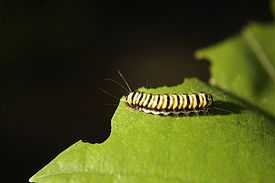Grapeleaf skeletonizer
| Grapeleaf skeletonizer | |
|---|---|
 | |
| Scientific classification | |
| Kingdom: | Animalia |
| Phylum: | Arthropoda |
| Class: | Insecta |
| Order: | Lepidoptera |
| Family: | Zygaenidae |
| Genus: | Harrisina |
| Species: | H. americana |
| Binomial name | |
| Harrisina americana Guerin-Meneville 1844 | |
The Grapeleaf Skeletonizer, Harrisina americana is a moth in the family Zygaenidae. It is widespread in the eastern half of the United States, and commonly noticed defoliating grapes, especially of the Virginia creeper (Parthenocissus quinquefolia). The western grapeleaf skeletonizer, Harrisina brillians is very similar to and slightly larger than H. americana, but their distributions are different. Members of this family all produce hydrogen cyanide, a potent antipredator toxin.
Life history
There are several generations per year in the south, and one in the north of its range.
Eggs
Eggs are lemon yellow, shaped like a capsule, slightly over 0.5 mm in length. They are laid in clusters on the underside of leaves, and hatch in about a week.
Larvae
Larvae are stout, with ten bright yellow bands or lines of dots, and eleven black bands alternating. They have hair-like setae that, if brushed against, will give a rash that lasts several days. They feed in groups that become progressively smaller as the larvae age. They constantly live on the underside of the leaves, and frequently line up side-by-side. Development from hatch to pupation takes about 40 days. The maximum length of the larvae is 15 mm.
Pupa
The pupa is brown, and lasts about two weeks in the summer, when multiple generations are possible. The pupa is also the overwintering stage, among leaves at the base of the plant.
Adult
Adult moths are uniformly black except for a yellowish or orange collar. The body and wings are long and narrow, and the abdomen is usually held curled upwards, with a tuft of hairs at the tip. Length of the moth is 8 to 12 mm, while the wing expanse is 22 to 28 mm. Adults are active visiting flowers during the day as well as at night. They live only a few days.
References
- Notes
- Bibliography
- Scoble, MJ, 1995., The Lepidoptera: form, function, and diversity. 2nd edition. Oxford Univ. Press.
- Wagner, DL, 2005. Caterpillars of Eastern North America. Princeton Univ. Press.
External links
- Image of the adult moth
- Drawing of larva, adult and pupa by John Abbot
- Grapeleaf skeletonizer on the University of Florida, IFAS Featured Creatures Web site